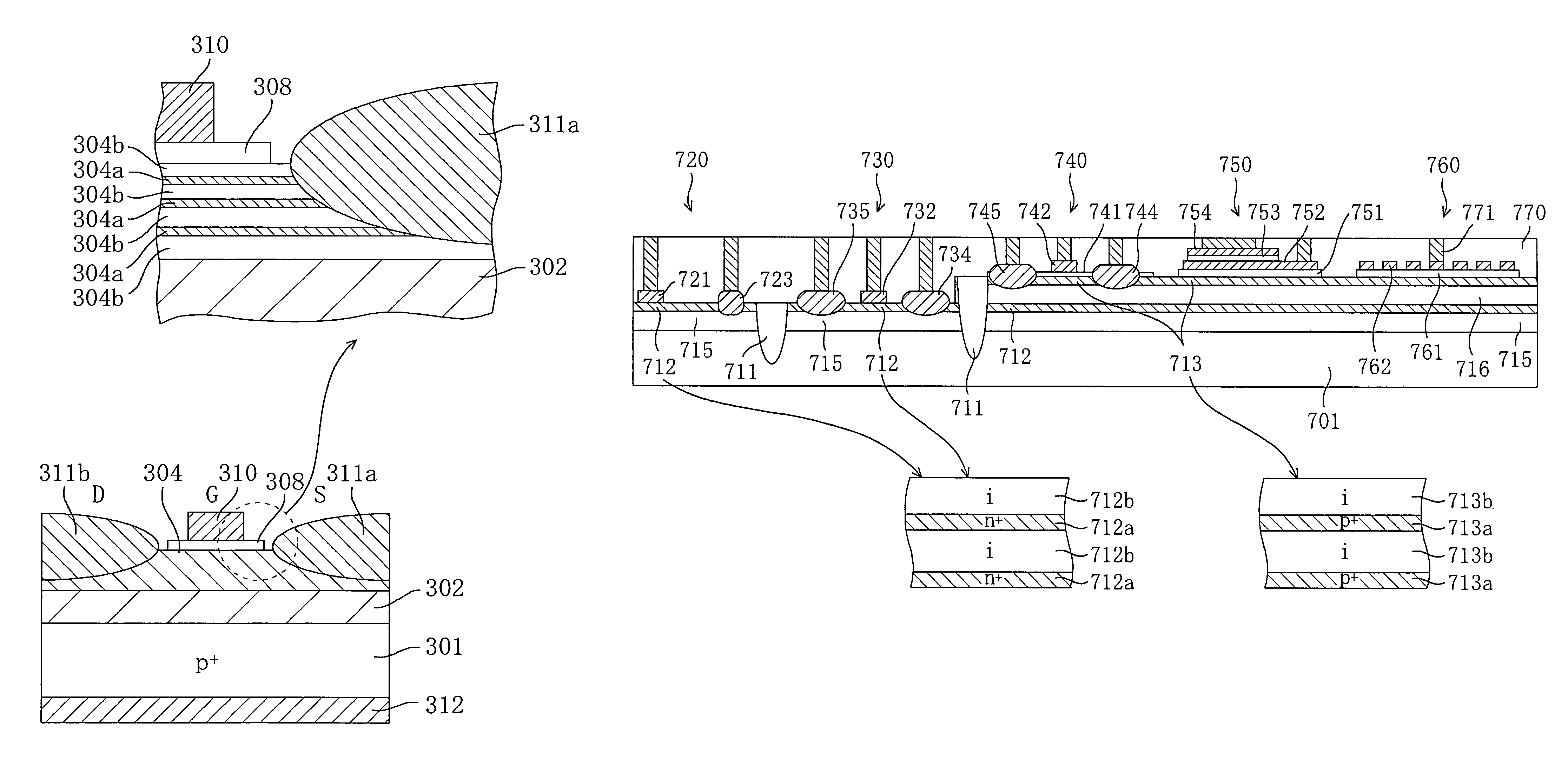Semiconductor device and method for manufacturing same
a semiconductor and ohmic electrode technology, applied in semiconductor devices, diodes, electrical devices, etc., can solve the problems of low doping concentration, low breakdown voltage, and difficulty in obtaining an ohmic electrode at a doping concentration of 10sup>17 /sup>cmsup>3 , to achieve the effect of low loss, low breakdown voltage and low contact resistance of the source electrod
- Summary
- Abstract
- Description
- Claims
- Application Information
AI Technical Summary
Benefits of technology
Problems solved by technology
Method used
Image
Examples
embodiment 1
[0042]“Structure of Semiconductor Device”
[0043]FIG. 1 is a cross sectional view showing a double-implanted, accumulation-mode MISFET (ACCUFET) using SiC according to a first embodiment of the present invention.
[0044]As shown in this figure, an accumulation-mode MISFET of this first embodiment comprises a low-resistance SiC substrate 101, a high-resistance SiC layer 102 that is epitaxially grown on the SiC substrate 101 and has a higher resistance than the SiC substrate 101, a p-type well region 103 formed by selectively implanting ions into the surface region of the high-resistance SiC layer 102, an n-type accumulation channel layer 104 having a multiple δ-doped layer (active region) formed on the surface region of the well region 103, and a contact layer 105 formed by implanting a p-type impurity at a high concentration into the well region 103. A gate insulating film 108 is formed on the accumulation channel layer 104, and a gate electrode 110 is formed on the gate insulating film...
embodiment 2
[0075]“Structure of Semiconductor Device”
[0076]FIG. 4 is a cross sectional view showing the structure of a trench MISFET constituting a semiconductor device according to a second embodiment of the present invention.
[0077]As shown in this figure, a trench MISFET of this second embodiment comprises a low-resistance SiC substrate 201, a high-resistance SiC layer 202 that is epitaxially grown on the SiC substrate 201 and has a higher resistance than the SiC substrate 201, a p-type base layer 203 formed by selectively implanting ions into the surface region of the high-resistance SiC layer 202, an n-type channel layer 204 having a multiple δ-doped layer (active region) formed along the wall surface of a trench which passes through part of the p-type base layer 203 and reaches the high-resistance SiC layer 202, and a contact region 205 formed by implanting a p-type impurity at a high concentration into the p-type base layer 203. A gate insulating film 208 is formed on the channel layer 20...
embodiment 3
[0099]FIG. 6 is a cross sectional view showing a schematic structure of a lateral p-channel MISFET according to a third embodiment. As shown in this figure, on an n-type SiC substrate 301 doped with nitrogen (n-type impurity) at a concentration of 1×1018 atoms·cm−3, there are provided an n-type base region 302 doped with nitrogen at a mean concentration of about 1×1017 atoms—cm−3, a multiple δ-doped layer 304 (active region) formed in the base region 302, a gate insulating film 308 of SiO2 formed on the multiple δ-doped layer 304, a gate electrode 310 composed of a Ni alloy film formed on the gate insulating film 308, source and drain electrodes 311a and 311b composed of a Ni alloy film contacting the multiple δ-doped layer 304 and the base region 302, and a back-surface electrode 312 composed of a Ni alloy film in ohmic contact with the back surface of the SiC substrate 301.
[0100]As shown in the right part of FIG. 6 under magnification, the multiple δ-doped layer 304 is composed of...
PUM
 Login to View More
Login to View More Abstract
Description
Claims
Application Information
 Login to View More
Login to View More - Generate Ideas
- Intellectual Property
- Life Sciences
- Materials
- Tech Scout
- Unparalleled Data Quality
- Higher Quality Content
- 60% Fewer Hallucinations
Browse by: Latest US Patents, China's latest patents, Technical Efficacy Thesaurus, Application Domain, Technology Topic, Popular Technical Reports.
© 2025 PatSnap. All rights reserved.Legal|Privacy policy|Modern Slavery Act Transparency Statement|Sitemap|About US| Contact US: help@patsnap.com



